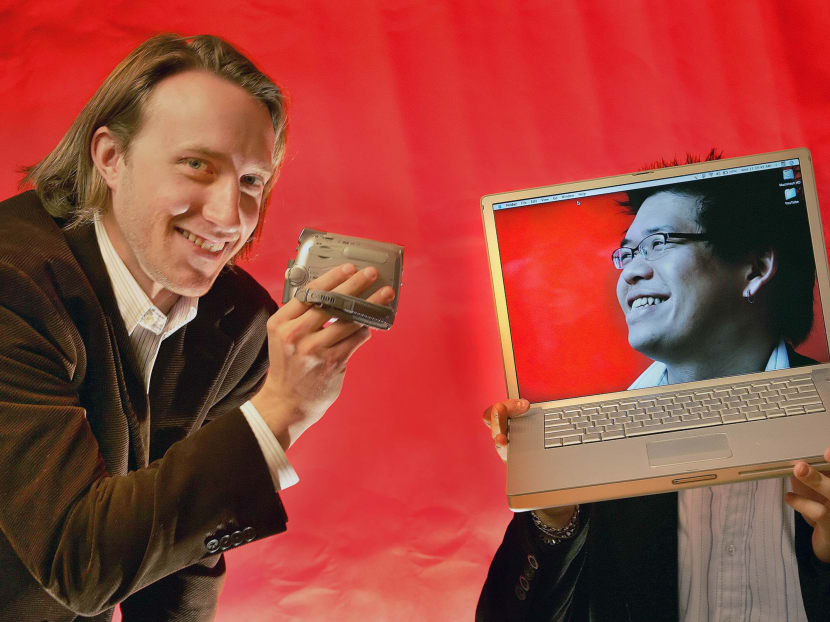YouTube's 1st decade shows sharing free content pays off
SAN FRANCISCO — YouTube’s legacy extends beyond its pioneering role in the Internet’s video revolution. The 10-year-old site provided a stage for exhibitionists, narcissists and activists to broadcast their opinions, show off their talents, expose abuses or just pass along their favourite clips of movies, TV shows, music, cute kittens and other interests.

In this March 29, 2006 file photo, YouTube cofounders Chad Hurley, 29, left, and Steven Chen, 27, pose for a photo with their laptops at their office loft in a San Mateo, California. Photo: AP
SAN FRANCISCO — YouTube’s legacy extends beyond its pioneering role in the Internet’s video revolution. The 10-year-old site provided a stage for exhibitionists, narcissists and activists to broadcast their opinions, show off their talents, expose abuses or just pass along their favourite clips of movies, TV shows, music, cute kittens and other interests.
The rampant sharing on YouTube quickly attracted a massive audience that loved watching what they wanted when they wanted, even if much of the material was being contributed by amateurs.
YouTube’s rapid rise demonstrated that influential media hubs could be built around free content supplied by an Internet service’s users. Other companies that went on to embrace a similar strategy included Facebook, which limited its online social network to college and high school students until opening up the service to anyone 13 or older beginning in September 2006. That was just before YouTube’s whirlwind success culminated in its US$1.76 billion (S$2.36 billion) sale to Google.
In the spirit of sharing popularised by YouTube, here are a few moments to remember from the site’s first decade:
MAJOR MILESTONES
YouTube’s potential to transform people’s viewing habits became apparent during the autumn of 2005 when a Nike soccer shoe ad called Touch of Gold became the first video on the site to be watched one million times.
The dance video Gangnam Style became the first YouTube video to surpass 1 billion views in 2012. The clip from South Korean rapper Psy still reigns as YouTube’s most-watched video at 2.3 billion views. The only other video to break the billion barrier so far has been Baby by Justin Bieber, but YouTube expects clips by singers Katy Perry, Shakira, Taylor Swift, Meghan Trainor and Miley Cyrus to eventually join the exclusive club.
In 2007, about six hours of video footage was being transferred to YouTube every minute. Now, about 300 hours of video is uploaded to YouTube each minute, or about 432,000 hours per day. That means it would take about 49 years to watch all the videos posted on YouTube on a typical day.
VIDEO VILLIANS
Most TV and movie executives initially reviled YouTube, contending the site’s early success stemmed from its lax controls against video pirates posting copyrighted clips. Even Google initially viewed the video site as a “rogue enabler” of content theft, according to internal documents that surfaced in a copyright lawsuit filed against YouTube.
YouTube steadfastly denied wrongdoing and, as a defence, pointed to its policy of removing pirated video whenever asked by a copyright holder.
Shortly after being bought by Google, YouTube built an automated detection system that prevents most unauthorised clips from appearing on its site.
THE BIG WINDFALL
In need of additional computing power and legal protection against the pirating claims, YouTube’s founders decided to sell in 2006. They negotiated the Google deal in a series of meetings in a Denny’s restaurant in Palo Alto, California, instead of YouTube’s dinky office located above a pizza parlour in nearby San Mateo. The purchase price was originally set at US$1.65 billion in Google stock, but the value of the shares had climbed by the time the deal closed in November 2006 to set the final price at US$1.76 billion.
The biggest winners were co-founders Chad Hurley, Steve Chen and Jawed Karim, who collectively received nearly US$700 million in Google stock. Mr Hurley now runs a mobile video site called MixBitApp. Mr Chen is an entrepreneur-in-residence at Google’s venture capital arm. Mr Karim is financing and advising startups at Y Ventures.
YouTube employed fewer than 70 people at the time of the sale, and at least 18 of them became millionaires. Other early investors in the site who pocketed smaller windfalls included TV talk show host Maury Povich and former network TV news broadcaster Forrest Sawyer.
WHAT IT’S WORTH NOW
Google has never disclosed how much money YouTube brings in or even if the site is profitable. The research firm eMarketer projects YouTube will sell about US$4.3 billion in advertising this year, after subtracting commissions and licensing fees. That would translate into about 7 per cent of Google’s projected revenue of US$60 billion this year after subtracting advertising commissions.
If it were an independent company, YouTube likely would be worth at least US$20 billion, based on investors’ assessment of Netflix – the Internet’s leading video subscription service. Netflix currently has a market value of US$37 billion, or about five-and-a-half times its projected revenue this year. AP





